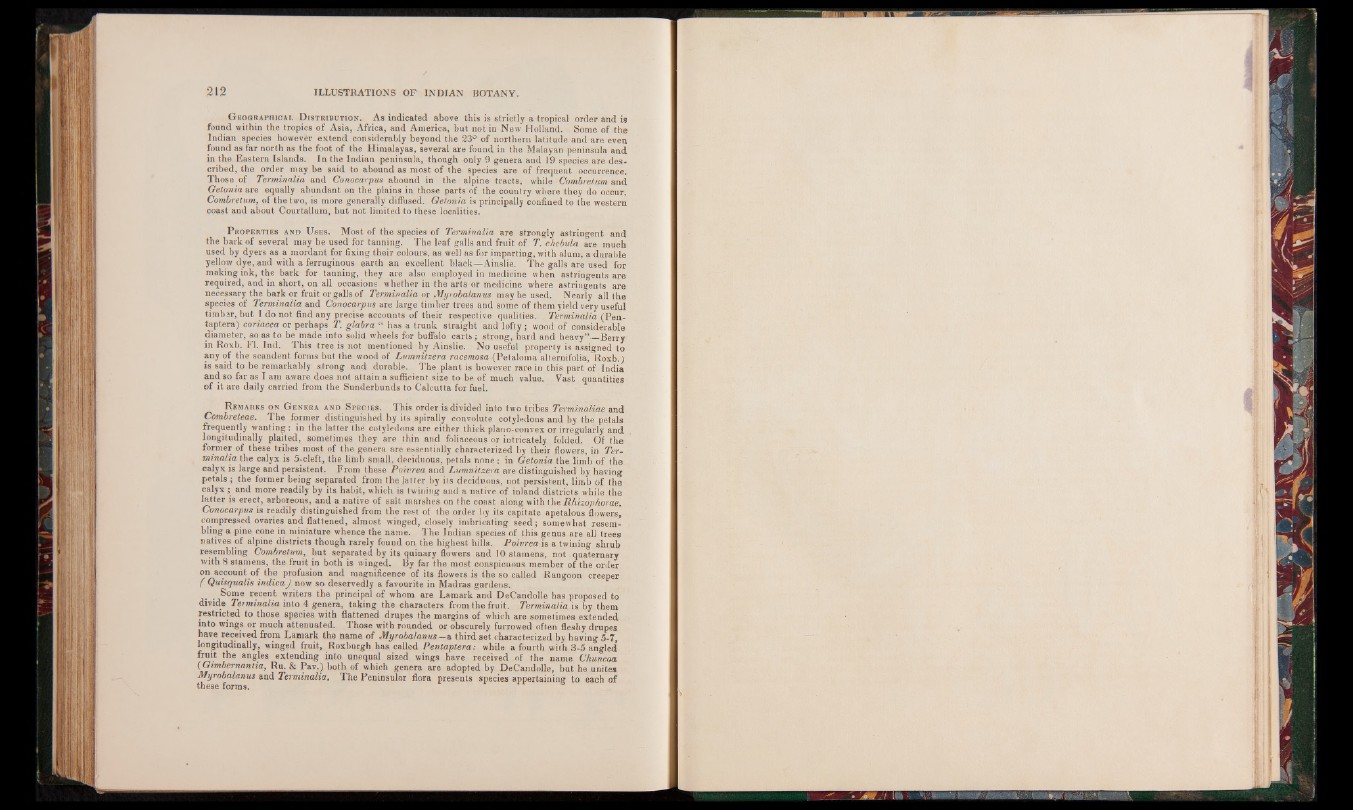
G eographical D istr ibu t io n . As indicated above this is strictly a tropical order and is
found within the tropics of Asia, Africa, and America, but notin New Holland. Some of the
Indian species however extend considerably beyond the 23° of northern latitude and are even
found as far north as the foot of the Himalayas, several are found in the Malayan peninsula and
in the Eastern Islands. In the Indian peninsula, though only 9 genera and 19 species are described,
the order may be said to abound as most of the species are of frequent occurrence.
Those of Termin a lia and Conocarpus abound in the alpine tracts, while Combretum and
Getonia are equally abundant on the plains in those parts of the country where they do occur.
Combretum, of the two, is more generally diffused. Getonia is principally confined to the western
coast and about Courtallum, but not limited to these localities.
P ro p er t ie s and U se s . Most of the species of Terminalia are strongly astringent and
the bark of several may be used for tanning. The leaf galls and fruit of T. chebula are much
used by dyers as a mordant for fixing their colours, as well as for imparting, with alum, a durable
yellow dye, and with a ferruginous earth an excellent black—Ainslie. The galls are used for
making ink, the bark for tanning, they are also employed in medicine when astringents are
required, and in short, on all occasions whether in the arts or medicine where astringents are
necessary the bark or fruit or galls of Terminalia or Myio b a la n u s may be used. Nearly all the
species of T e rmin a lia and Conocarpus are large timber trees and some of them yield very useful
timbsr, but I do not find any precise accounts of their respective qualities. Termin a lia (Pen-
taptera) coriacea or perhaps T. g labra “ has a trunk straight and lofty; wood of considerable
diameter, so as to be made into solid wheels for buffalo carts; strong, hard and heavy”_Berry
in Roxb. FI. Ind. This tree is not mentioned by Ainslie. No useful property is assigned to
any of the scandent forms but the wood of L um n itz e ra racemosa (Petaloma alternifolia, Roxb.)
is said to be remarkably strong and durable. The plant is however rare in this part of India
and so far as I am aware does not attain a sufficient size to be of much value. Vast quantities
of it are daily carried from the Sunderbunds to Calcutta for fuel.
R emarks on G enera and S pec ie s . This order is divided into two tribes Terminaliae and
Combreteae. The former distinguished by its spirally convolute cotyledons and by the petals
frequently wanting : in the latter the cotyledons are either thiek plano-convex or irregularly and
longitudinally plaited, sometimes they are thin and foliaceous or intricately folded. Of the
former of these tribes most of the genera are essentially characterized by their flowers, in Term
in a lia the calyx is 5-cleft, the limb small, deciduous, petals none: in Getonia the limb of the
calyx is large and persistent. From these Po ivrea and L um n itze ra are distinguished by having
petals; the former being separated from the latter by its deciduous, not persistent, limb of the
calyx; and more readily by its habit, which is twining and a native of inland districts while the
latter is erect, arboreous, and a native of salt marshes on the coast along with the Rhizophorae,
Conocarpus is readily distinguished from the rest of the order by its capitate apetalous flowers,
compressed ovaries and flattened, almost winged, closely imbricating seed; somewhat resembling
a pine cone in miniature whence the name. The Indian species of this genus are all trees
natives of alpine districts though rarely found on the highest hills. P o ivrea is a twining shrub
resembling Combretum, but separated by its quinary flowers and 10 stamens, not quaternary
with 8 stamens, the fruit in both is winged. By far the most conspicuous member of the order
on account of the profusion and magnificence of its flowers is the so called Rangoon creeper
( Quisqualis in d i c a j dow so deservedly a favourite in Madras gardens.
Some recent writers the principal of whom are Lamark and DeCandolle has proposed to
divide Termin a lia into 4 genera, taking the characters from the fruit. Terminalia is by them
restricted to those species with flattened drupes the margins of which are sometimes extended
into wings or much attenuated. Those with rounded or obscurely furrowed often fleshy drupes
have received from Lamark the name of Myrobalanus —a third set characterized by having 5-7,
longitudinally, winged fruit, Roxburgh has called P e n ta p te ra : while a fourth with 3-5 angled
fruit the angles extending into unequal sized wings have received of the name Chuncoa
(G imbernantia, Ru. & Pav.) both of which genera are adopted by DeCandolle, but he unites
M yrobalanus and Termin a lia . The Peninsular flora presents species appertaining to each of
these forms.